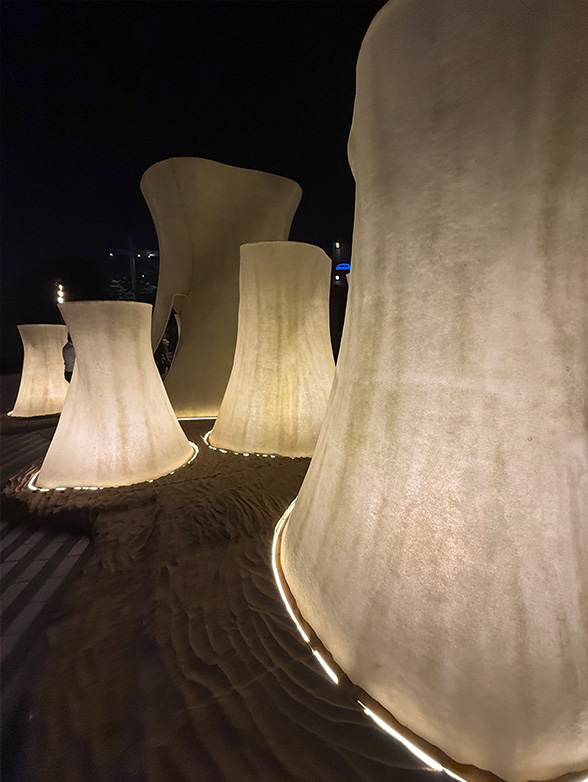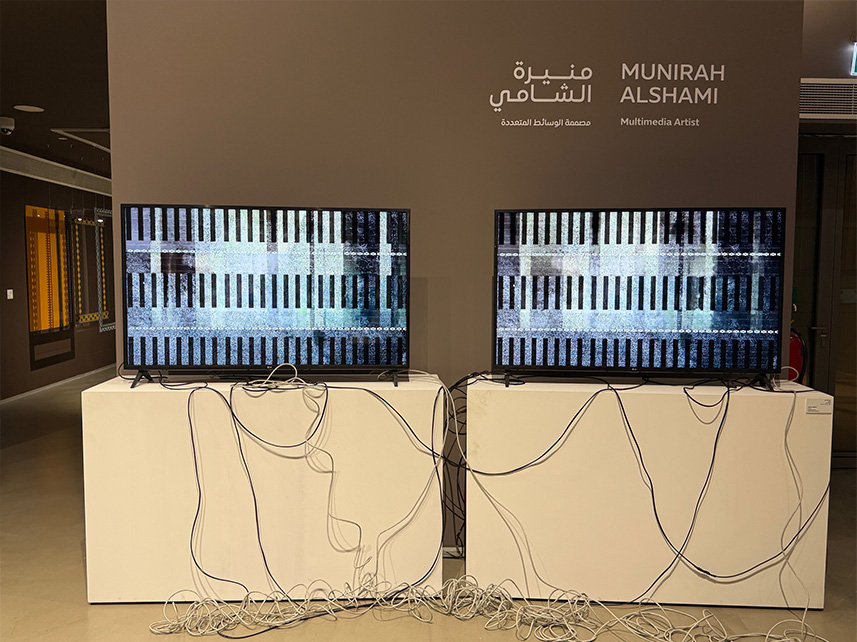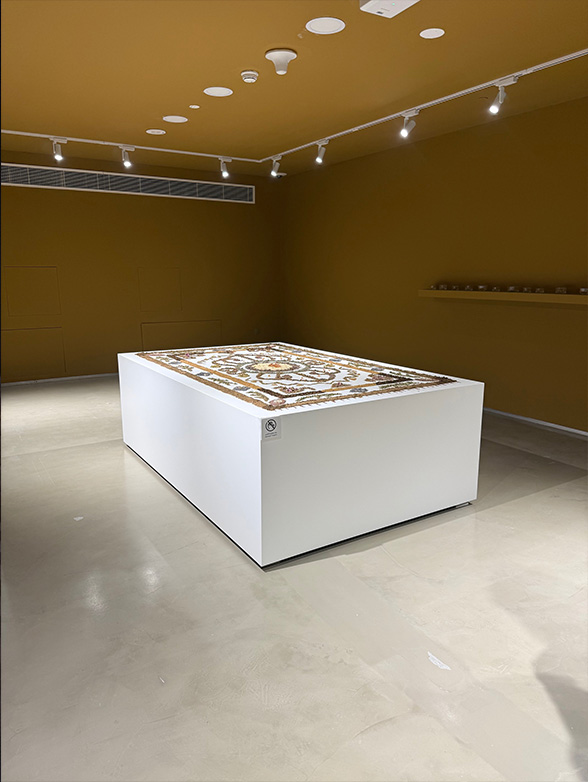There’s something quietly powerful about watching a city define itself through light. In Dubai, that feels especially true. This November, Dhai Dubai returned to Al Wasl Plaza at Expo City Dubai – an architectural heart that has itself become a symbol of possibility – to unveil its second edition of the first-ever Emirati-led light art exhibition. Held in partnership with Dubai Culture, this year’s edition ran from 12 until 18 November, 2025, under the theme Light Influences Life which felt less like a concept and more like a way of understanding the UAE’s evolving creative consciousness.
 Curated by Amna Abulhoul and Anthony Bastic AM, Dhai Dubai brought together three generations of Emirati artists whose practices span painting, architecture, video, jewellery design, sculpture, performance, and archival research. Instead of standing apart, their works folded naturally into one another; Fatma Lootah’s emotive abstraction, Mohammed Kazem’s sensitivity to environment, the architectural clarity of Khalid Al Banna and AlZaina Lootah, the material storytelling of Alia Bin Omair, and the archival depth of Ahmad AlAreef and Hessa Alghandi. Their approaches are distinct but harmonised, forming a collective language that reflects how light functions in this region: as memory, as orientation, as the quiet architecture of daily life.
Curated by Amna Abulhoul and Anthony Bastic AM, Dhai Dubai brought together three generations of Emirati artists whose practices span painting, architecture, video, jewellery design, sculpture, performance, and archival research. Instead of standing apart, their works folded naturally into one another; Fatma Lootah’s emotive abstraction, Mohammed Kazem’s sensitivity to environment, the architectural clarity of Khalid Al Banna and AlZaina Lootah, the material storytelling of Alia Bin Omair, and the archival depth of Ahmad AlAreef and Hessa Alghandi. Their approaches are distinct but harmonised, forming a collective language that reflects how light functions in this region: as memory, as orientation, as the quiet architecture of daily life.
As Abulhoul reflects, the selected artists form “a radiant reflection of the UAE’s extraordinary spectrum of talent… seven Emirati voices, each with their own language of light.” In Al Wasl Plaza, these languages met, collided, and harmonised – personal narratives becoming part of a shared cultural constellation. What unfolded was not just an exhibition, but a moment where individual practices illuminate collective identity.
 The wider cultural terrain surrounding Dhai Dubai only amplified this feeling. Earlier in the day, before arriving at Al Wasl Plaza at night, my first stop had been the Etihad Museum – an architectural statement that sets the tone for understanding the UAE’s relationship to memory, narrative, and the act of nation-building. Designed as an unfurled manuscript with seven bronze columns representing the pens of the founding fathers, the building reflects a clarity and restraint that feel deeply aligned with the country’s ethos. Inside, a meticulous sequence guides visitors through the years 1968 to 1974 via documents, films, testimonies, and interactive displays, all assembled with a level of care that mirrors the precision of the national story being told.
The wider cultural terrain surrounding Dhai Dubai only amplified this feeling. Earlier in the day, before arriving at Al Wasl Plaza at night, my first stop had been the Etihad Museum – an architectural statement that sets the tone for understanding the UAE’s relationship to memory, narrative, and the act of nation-building. Designed as an unfurled manuscript with seven bronze columns representing the pens of the founding fathers, the building reflects a clarity and restraint that feel deeply aligned with the country’s ethos. Inside, a meticulous sequence guides visitors through the years 1968 to 1974 via documents, films, testimonies, and interactive displays, all assembled with a level of care that mirrors the precision of the national story being told.
Yet nothing resonates more deeply than Union House (Dar Al Etihad), preserved at the heart of the complex. Its circular, window-lined chamber offers a symbolic transparency: the clarity of vision and collective decision-making that shaped the federation. Standing in that room, surrounded by the architectural echo of a pivotal moment, the day’s unfolding narrative began to align – the idea of light not only as illumination, but as a metaphor for vision, formation, and continuity.

From there, the path led to the House of Arts, formerly the Morocco Pavilion, where Interwoven translated the Bedouin weaving craft of Al Sadu into a contemporary choreography of pattern, motion, and light. The pavilion itself deepened the experience: a tall, earthen-hued structure built around an internal courtyard, its floors connected by rising ramps and balconies that look down into a shared central void. Sound moves unusually well inside it; voices slip upward, footsteps echo downward. The architecture feels like a modern interpretation of a communal Middle Eastern gathering space; open, resonant, intimate.
Within this setting, Interwoven unfolded with an unexpected immediacy. Threads stretched across the space, patterns elongated into shadows, and the visual logic of weaving transformed into something spatial and almost cinematic. Two works, in particular, reframed the idea of the carpet as a vessel of memory.

Noura Alserkal’s The Magic Carpet 2.0 assembled spices and familiar foods from Middle Eastern kitchens – things we grew up smelling, reaching for, stirring – into a carpet-like composition. Arranged meticulously on a table, these aromatic elements turned scent into a structural material. Aroma became the pattern; memory became the warp and weft. The piece treated olfaction not as a sensory but as a form of storytelling; a way of mapping belonging, migration, and the shared language of domestic life.
In contrast, the woven works of Maryam Al-Homaid offered a more grounded, tactile counterpoint. Her carpets draw from traditional layouts – stacked motifs, mirrored forms, freehand geometries – yet they speak in a distinctly contemporary voice. Many of her textiles read like portraits of place: reimagined city grids, shifting neighbourhood lines, or abstractions of architectural rhythms. They feel archival and speculative at once, as if holding the memory of a place while imagining its next version. Al-Homaid’s weaving carries the weight of continuity: pattern not as repetition, but as remembrance.
Together, in the pavilion’s inward-facing court, Alserkal’s scent-carpet and Al-Homaid’s woven cartographies formed a dialogue – ephemeral memory against material lineage, scent against thread. With light sliding across the walls like stretched fibres, the works felt not like individual statements but like contributions to a shared, evolving vocabulary of memory.
 By evening, arriving at Dhai Dubai at Al Wasl Plaza felt like entering the final chapter of a single, continuous narrative. The earlier encounters with the nation’s manuscript, with the woven interplay of scent and cloth seemed to converge within the plaza’s sweeping architecture. Under the dome of Al Wasl and within the gathering of three generations of Emirati artists, light expanded from symbol to medium, from metaphor to material. Touring the installations at night revealed how their distinct practices resonate with one another: light as memory, light as environment, light as design, light as testimony.
By evening, arriving at Dhai Dubai at Al Wasl Plaza felt like entering the final chapter of a single, continuous narrative. The earlier encounters with the nation’s manuscript, with the woven interplay of scent and cloth seemed to converge within the plaza’s sweeping architecture. Under the dome of Al Wasl and within the gathering of three generations of Emirati artists, light expanded from symbol to medium, from metaphor to material. Touring the installations at night revealed how their distinct practices resonate with one another: light as memory, light as environment, light as design, light as testimony.
The works collided and harmonised like voices in a shared constellation, illuminating a cultural landscape where personal identity and collective history intertwine. It became clear that these sites; Etihad Museum, the House of Arts, and Dhai Dubai, are not separate cultural encounters but interdependent modes of storytelling.
Moving through them in sequence felt like turning the pages of the same, still-unfurling text: The Etihad Museum anchors the origin story, Interwoven demonstrates how tradition continues to evolve through scent, geometry, cloth, and craft, and Dhai Dubai gathers these threads to illuminate the present moment.
Together, they revealed a nation articulating itself through light, memory, design, and narrative, a place where the past and future are not opposites, but collaborators, woven tightly together, threaded through with light.